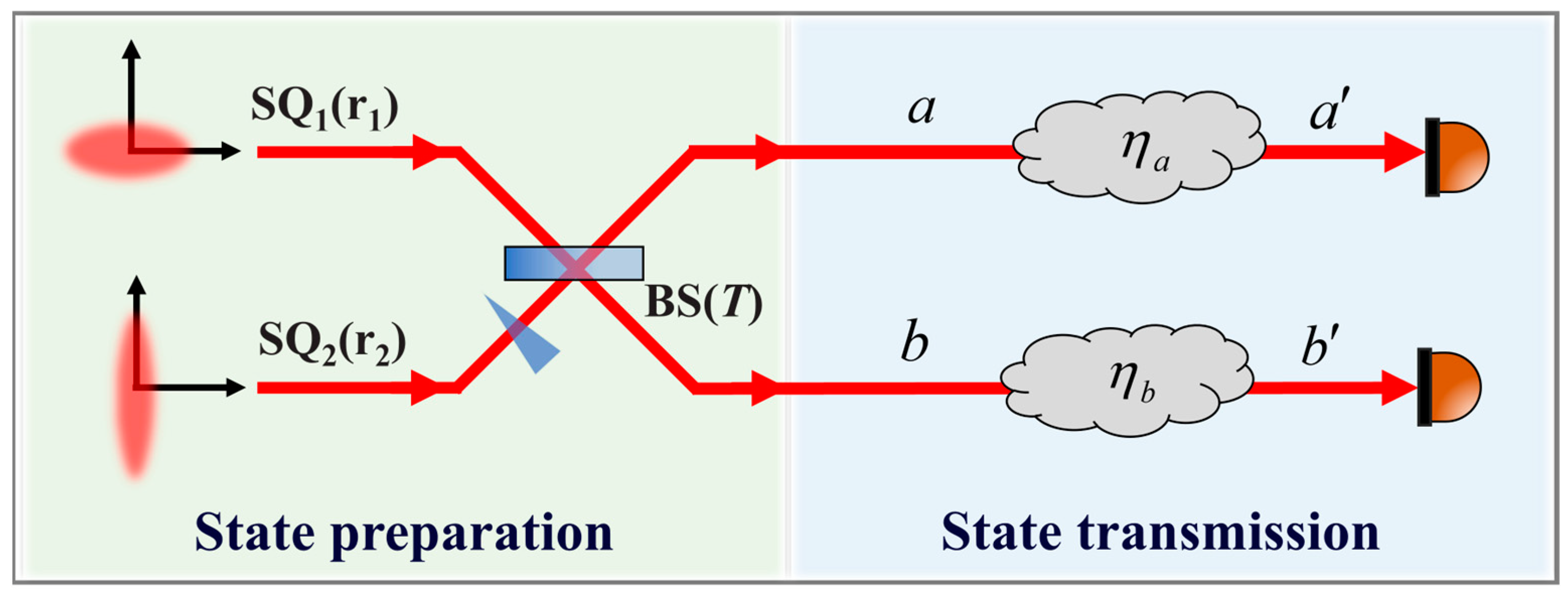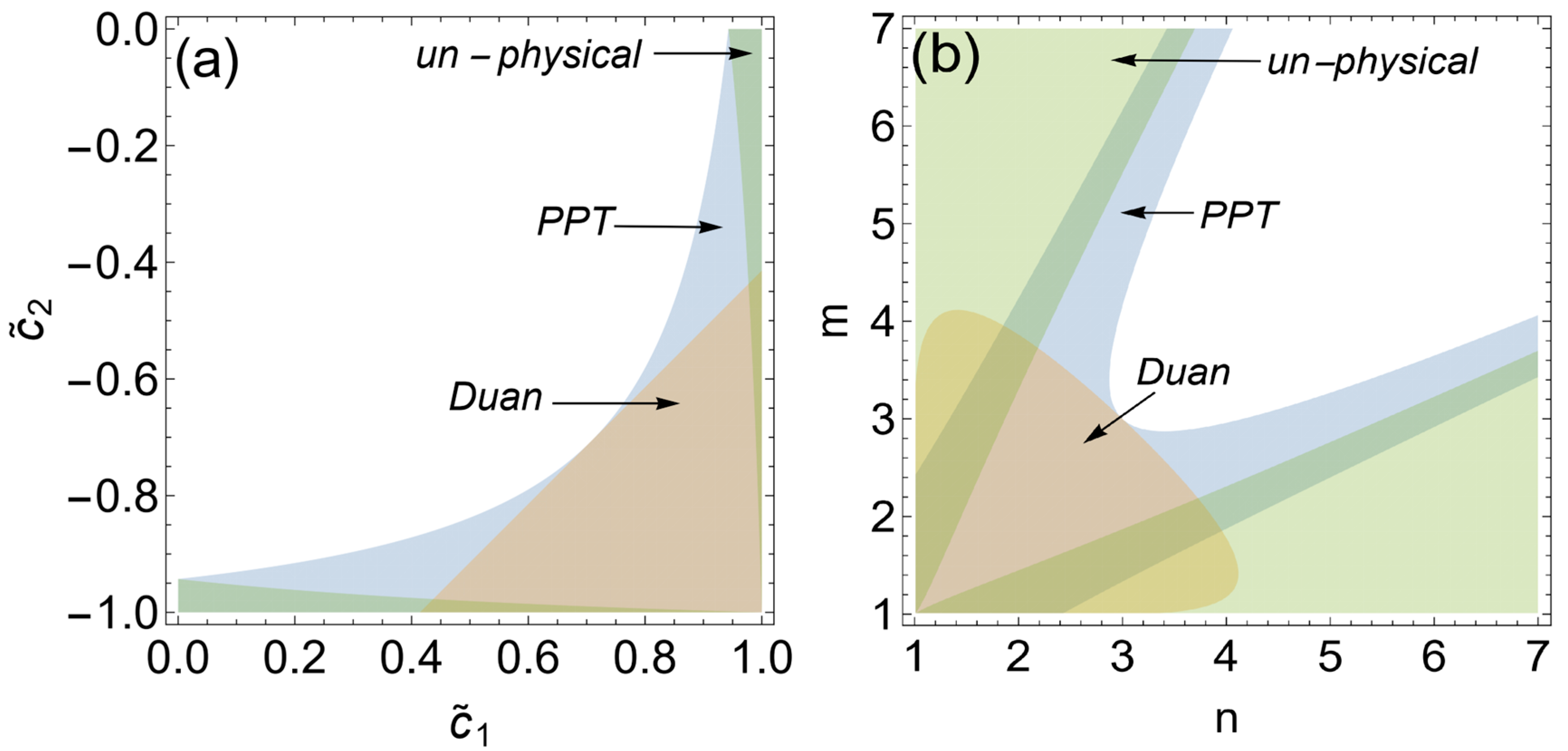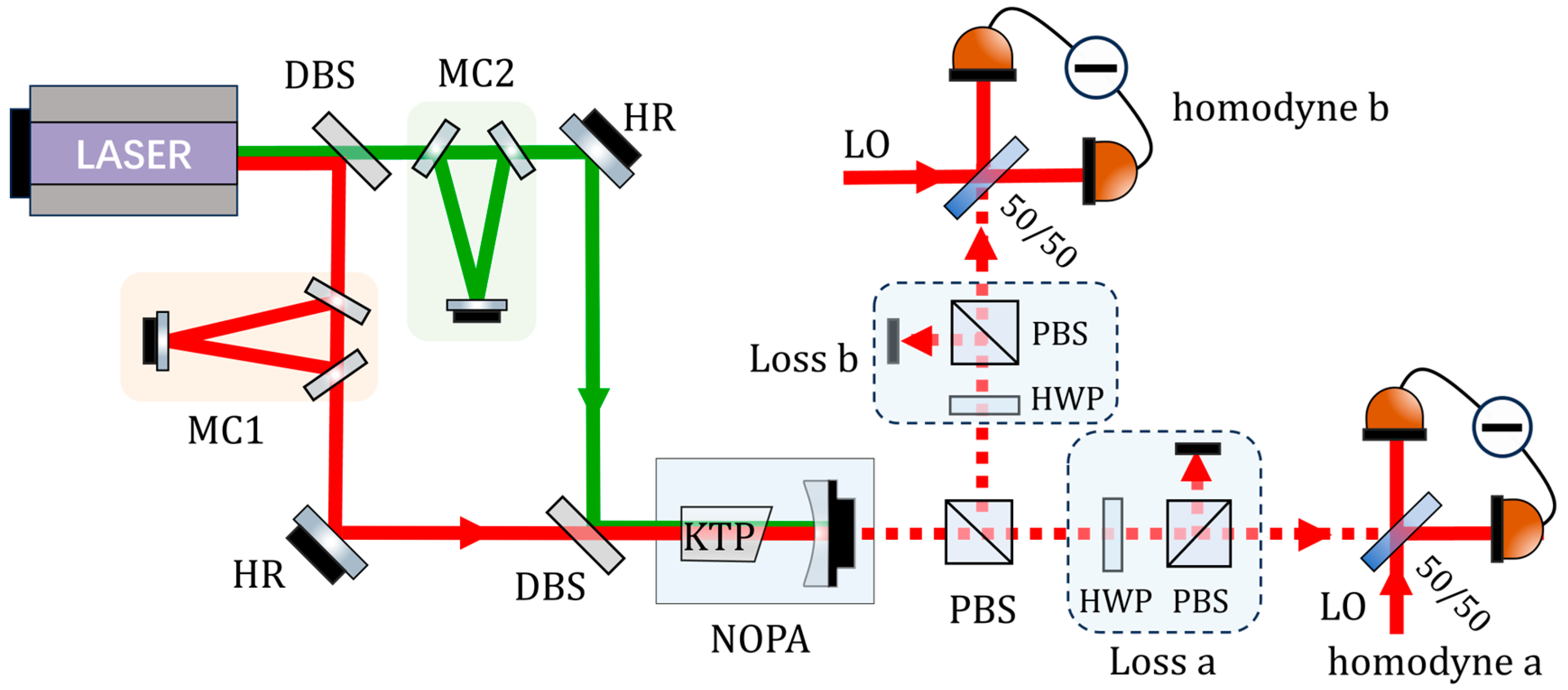Missed Detection of Entanglement in Two-Mode Squeezed States Based on the Inseparability Criterion
Abstract
:1. Introduction
2. Theoretical Analysis
2.1. Asymmetry of Two-Mode Gaussian States
2.2. Missed Detection of Entanglement
3. Experimental and Results
4. Conclusions
Author Contributions
Funding
Institutional Review Board Statement
Informed Consent Statement
Data Availability Statement
Conflicts of Interest
References
- Huang, J.; Li, X.; Chen, X.; Zhai, C.; Zheng, Y.; Chi, Y.; Li, Y.; He, Q.; Gong, Q.; Wang, J. Demonstration of hypergraph-state quantum information processing. Nat. Commun. 2024, 15, 2601. [Google Scholar] [CrossRef]
- Blais, A.; Girvin, S.M.; Oliver, W.D. Quantum information processing and quantum optics with circuit quantum electrodynamics. Nat. Phys. 2020, 16, 247–256. [Google Scholar] [CrossRef]
- Li, W.; Zhang, L.; Tan, H.; Lu, Y.; Liao, S.-K.; Huang, J.; Li, H.; Wang, Z.; Mao, H.-K.; Yan, B.; et al. High-rate quantum key distribution exceeding 110 Mb s–1. Nat. Photon. 2023, 17, 416–421. [Google Scholar] [CrossRef]
- Chen, Y.A.; Zhang, Q.; Chen, T.Y.; Cai, W.-Q.; Liao, S.-K.; Zhang, J.; Chen, K.; Yin, J.; Ren, J.-G.; Chen, Z.; et al. An integrated space-to-ground quantum communication network over 4,600 kilometres. Nature 2021, 589, 214–219. [Google Scholar] [CrossRef] [PubMed]
- Zapatero, V.; van Leent, T.; Arnon-Friedman, R.; Liu, W.-Z.; Zhang, Q.; Weinfurter, H.; Curty, M. Advances in device-independent quantum key distribution. npj Quantum Inf. 2023, 9, 10. [Google Scholar] [CrossRef]
- Maring, N.; Fyrillas, A.; Pont, M.; Ivanov, E.; Stepanov, P.; Margaria, N.; Hease, W.; Pishchagin, A.; Lemaître, A.; Sagnes, I.; et al. A versatile single-photon-based quantum computing platform. Nat. Photon. 2024, 18, 603–609. [Google Scholar] [CrossRef]
- Zhang, Z.; You, C.; Magaña-Loaiza, O.S.; Fickler, R.; León-Montiel, R.d.J.; Torres, J.P.; Humble, T.; Liu, S.; Xia, Y.; Zhuang, Q. Entanglement-based quantum information technology: A tutorial. Adv. Opt. Photonics 2024, 16, 60–162. [Google Scholar] [CrossRef]
- Barbosa, F.; Coelho, A.; de Faria, A.; Cassemiro, K.N.; Villar, A.S.; Nussenzveig, P.; Martinelli, M. Robustness of bipartite Gaussian entangled beams propagating in lossy channels. Nat. Photon 2010, 4, 858–861. [Google Scholar] [CrossRef]
- Chang, C.W.; Vadiraj, A.M.; Bourassa, J.; Balaji, B.; Wilson, C.M. Quantum-enhanced noise radar. Appl. Phys. Lett. 2019, 114, 112601. [Google Scholar] [CrossRef]
- Karsa, A.; Ghalaii, M.; Pirandola, S. Noiseless linear amplification in quantum target detection using Gaussian states. Quantum Sci. Technol. 2022, 7, 035026. [Google Scholar] [CrossRef]
- Gonzalez-Raya, T.; Pirandola, S.; Sanz, M. Satellite-based entanglement distribution and quantum teleportation with continuous variables. Commun. Phys. 2024, 7, 126. [Google Scholar] [CrossRef]
- Hosseinidehaj, N.; Babar, Z.; Malaney, R.; Ng, S.X.; Hanzo, L. Satellite-Based Continuous-Variable Quantum Communications: State-of-the-Art and a Predictive Outlook. IEEE Commun. Surv. Tutor. 2019, 21, 881–919. [Google Scholar] [CrossRef]
- Steinlechner, S.; Bauchrowitz, J.; Eberle, T.; Schnabel, R. Strong Einstein-Podolsky-Rosen steering with unconditional entangled states. Phys. Rev. A 2013, 87, 022104. [Google Scholar] [CrossRef]
- Reid, M.D.; Drummond, P.D. Quantum correlations of phase in nondegenerate parametric oscillation. Phys. Rev. Lett. 1988, 60, 2731–2733. [Google Scholar] [CrossRef] [PubMed]
- Simon, R. Peres-Horodecki separability criterion for continuous variable systems. Phys. Rev. Lett. 2000, 84, 2726. [Google Scholar] [CrossRef] [PubMed]
- Tserkis, S.; Ralph, T.C. Quantifying entanglement in two-mode Gaussian states. Phys. Rev. A 2017, 96, 062338. [Google Scholar] [CrossRef]
- Duan, L.M.; Giedke, G.; Cirac, J.I.; Zoller, P. Inseparability Criterion for Continuous Variable Systems. Phys. Rev. Lett. 2000, 84, 2722. [Google Scholar] [CrossRef] [PubMed]
- Fedrizzi, A.; Ursin, R.; Herbst, T.; Nespoli, M.; Prevedel, R.; Scheidl, T.; Tiefenbacher, F.; Jennewein, T.; Zeilinger, A. High-fidelity transmission of entanglement over a high-loss free-space channel. Nat. Phys. 2009, 5, 389–392. [Google Scholar] [CrossRef]
- Xu, J.S.; Xu, X.Y.; Li, C.F.; Zhang, C.-J.; Zou, X.-B.; Guo, G.-C. Experimental investigation of classical and quantum correlations under decoherence. Nat. Commun. 2010, 1, 7. [Google Scholar] [CrossRef] [PubMed]
- Deng, X.; Liu, Y.; Wang, M.; Su, X.; Peng, K. Sudden death and revival of Gaussian Einstein–Podolsky–Rosen steering in noisy channels. npj Quantum Inf. 2021, 7, 65. [Google Scholar] [CrossRef]
- Li, F.; Li, T.; Agarwal, G.S. Experimental study of decoherence of the two-mode squeezed vacuum state via second harmonic generation. Phys. Rev. Res. 2021, 3, 033095. [Google Scholar] [CrossRef]
- Buono, D.; Nocerino, G.; Porzio, A.; Solimeno, S. Experimental analysis of decoherence in continuous-variable bipartite systems. Phys. Rev. A 2012, 86, 042308. [Google Scholar] [CrossRef]
- Bowen, W.P.; Schnabel, R.; Lam, P.K.; Ralph, T.C. Experimental investigation of continuous-variable quantum teleportation. Phys. Rev. Lett. 2003, 90, 043601. [Google Scholar] [CrossRef]
- Cai, C.; Ma, L.; Li, J.; Guo, H.; Liu, K.; Sun, H.; Yang, R.; Gao, J. Generation of a continuous-variable quadripartite cluster state multiplexed in the spatial domain. Photon. Res. 2018, 6, 479–484. [Google Scholar] [CrossRef]
- Li, J.; Li, J.-M.; Cai, C.-X.; Sun, H.-X.; Liu, K.; Gao, J.-R. Enhancement of continuous-variable hyperentanglement by optimizing pump mode. Acta Phys. Sin. 2019, 68, 034204. [Google Scholar] [CrossRef]
- Masada, G. Evaluation Method for Inseparability of Two-Mode Squeezed Vacuum States in a Lossy Optical Medium. Tamagawa Univ. Quantum ICT Res. Inst. Bull. 2015, 5, 19–23. [Google Scholar]
- Masada, G. Two-mode squeezed light source for quantum illuminaiton and quantum imaging II. In Quantum Communications Quantum Imaging XIV; SPIE: Bellingham, WA, USA, 2016. [Google Scholar]
- Masada, G. Verification of quantum entanglement of two-mode squeezed light source towards quantum radar and imaging. In Quantum Communications Quantum Imaging XV; SPIE: Bellingham, WA, USA, 2017. [Google Scholar]
- Masada, G. Non-Classical Correlation of Asymmetric Two-Mode Squeezed Vacuum states. Tamagawa Univ. Quantum ICT Res. Inst. Bull. 2017, 7, 33. [Google Scholar]
- Masada, G. Non-classical correlation of two-mode squeezed light in asymmetric optical-loss conditions. In Quantum Communications Quantum Imaging XVI; SPIE: Bellingham, WA, USA, 2018. [Google Scholar]
- Feng, J.; Wan, Z.; Li, Y.; Zhang, K. Distribution of continuous variable quantum entanglement at a telecommunication wavelength over 20 km of optical fiber. Opt. Lett. 2017, 42, 3399–3402. [Google Scholar] [CrossRef] [PubMed]
- Zhao, H.; Feng, J.-X.; Sun, J.-K.; Li, Y.-J.; Zhang, K.-S. Entanglement robustness of continuous variable Einstein-Podolsky-Rosen-entangled state distributed over optical fiber channel. Acta Phys. Sin. 2022, 71, 094202. [Google Scholar] [CrossRef]
- Zhang, W.; Li, R.; Wang, Y.; Wang, X.; Tian, L.; Zheng, Y. Security analysis of continuous variable quantum key distribution based on entangled states with biased correlations. Opt. Express 2021, 29, 22623–22635. [Google Scholar] [CrossRef]
- Luong, D.; Balaji, B. Quantum two-mode squeezing radar and noise radar: Covariance matrices for signal processing. IET Radar Sonar Navig. 2020, 14, 97. [Google Scholar] [CrossRef]
- Zhuang, Q. Quantum Ranging with Gaussian Entanglement. Phys. Rev. Lett. 2021, 126, 240501. [Google Scholar] [CrossRef] [PubMed]
- Branciard, C.; Cavalcanti, E.G.; Walborn, S.P.; Scarani, V.; Wiseman, H.M. One-sided device-independent quantum key distribution: Security, feasibility, and the connection with steering. Phys. Rev. A 2012, 85, 010301. [Google Scholar] [CrossRef]
- Wagner, K.; Janousek, J.; Armstrong, S.; Morizur, J.-F.; Lam, P.K.; Bachor, H.-A. Asymmetric EPR entanglement in continuous variable systems. J. Phys. At. Mol. Opt. Phys. 2014, 47, 225502. [Google Scholar] [CrossRef]
- Bowen, W.P.; Lam, P.K.; Ralph, T.C. Biased EPR entanglement and its application to teleportation. J. Mod. Opt. 2003, 50, 801–813. [Google Scholar] [CrossRef]
- Zhao, J. Post-Selection-Based Continuous Variable Quantum Information Processing. Ph.D. Thesis, Australian National University, Canberra, ACT, Australia, July 2019. [Google Scholar]
- Houde, M.; Govia, L.; Clerk, A. Loss Asymmetries in Quantum Traveling-Wave Parametric Amplifiers. Phys. Rev. Appl. 2019, 12, 034054. [Google Scholar] [CrossRef]
- Gao, X.; Isoard, M.; Sun, F.; Lopetegui, C.E.; Xiang, Y.; Parigi, V.; He, Q.; Walschaers, M. Correlation-Pattern-Based Continuous Variable Entanglement Detection through Neural Networks. Phys. Rev. Lett. 2024, 132, 220202. [Google Scholar] [CrossRef] [PubMed]
- Luo, Y.-J.; Liu, J.-M.; Zhang, C. Detecting genuine multipartite entanglement via machine learning. Phys. Rev. A 2023, 108, 052424. [Google Scholar] [CrossRef]
- Qu, Y.D.; Zhang, R.Q.; Shen, S.Q.; Yu, J.; Li, M. Entanglement Detection with Complex-Valued Neural Networks. Int. J. Theor. Phys. 2023, 62, 206. [Google Scholar] [CrossRef]






Disclaimer/Publisher’s Note: The statements, opinions and data contained in all publications are solely those of the individual author(s) and contributor(s) and not of MDPI and/or the editor(s). MDPI and/or the editor(s) disclaim responsibility for any injury to people or property resulting from any ideas, methods, instructions or products referred to in the content. |
© 2025 by the authors. Licensee MDPI, Basel, Switzerland. This article is an open access article distributed under the terms and conditions of the Creative Commons Attribution (CC BY) license (https://creativecommons.org/licenses/by/4.0/).
Share and Cite
Cai, C.; Diao, W.; Feng, F.; Yang, W.; Su, X.; Zhao, W.; Ge, J.; Ma, L.; Huo, N.; Liu, Y.; et al. Missed Detection of Entanglement in Two-Mode Squeezed States Based on the Inseparability Criterion. Appl. Sci. 2025, 15, 1013. https://doi.org/10.3390/app15031013
Cai C, Diao W, Feng F, Yang W, Su X, Zhao W, Ge J, Ma L, Huo N, Liu Y, et al. Missed Detection of Entanglement in Two-Mode Squeezed States Based on the Inseparability Criterion. Applied Sciences. 2025; 15(3):1013. https://doi.org/10.3390/app15031013
Chicago/Turabian StyleCai, Chunxiao, Wenting Diao, Fupan Feng, Wenhai Yang, Xinyu Su, Weigang Zhao, Jinman Ge, Long Ma, Nan Huo, Yanhong Liu, and et al. 2025. "Missed Detection of Entanglement in Two-Mode Squeezed States Based on the Inseparability Criterion" Applied Sciences 15, no. 3: 1013. https://doi.org/10.3390/app15031013
APA StyleCai, C., Diao, W., Feng, F., Yang, W., Su, X., Zhao, W., Ge, J., Ma, L., Huo, N., Liu, Y., & Duan, C. (2025). Missed Detection of Entanglement in Two-Mode Squeezed States Based on the Inseparability Criterion. Applied Sciences, 15(3), 1013. https://doi.org/10.3390/app15031013






